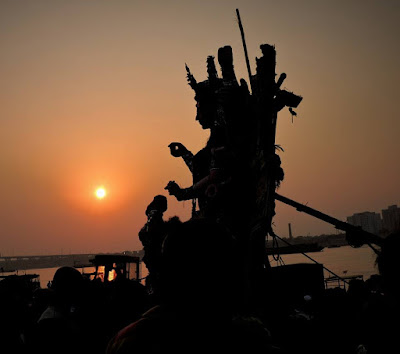Dussehra / Maha Navami
Smiling blue skies trimmed with white woolen fogs, delicate breeze, warm sunlight and the `kash' blooms usher in the month of Aswin (September-October). It is the perfect open door for Durga Puja, the major festivity of Bengal, passing on with it new might want to the hearts of all Bengalis.
Soon it is Bijoyam the day when the photos are taken in a parade and immersed in the stream. Bengalis do an inversion to their regular lives to hold up one more year to welcome the goddess Durga. Durga Puja, as we most likely are mindful it today, is a festival that ties together people from a wide range of various foundations, autonomous of station, proclamation of confidence and religion. It is a gathering festivity, however in a couple of houses in any case, they have private pujas. Durgotsava has wound up being a wellspring of business for people in different circles. The photo maker, the pastor, the bloom masters, the dhaki (drum. blender), nourishment shippers, confectioners, and volunteers are each of the essential pieces of this festival. It is a period to exchange endowments. This is a season for new articles of clothing.
They went to Vishnu who let them realize that it would be workable for some individual other than a God to pound Mahisasura. The name Tilottoma and not Durga is found in the Puranas. She was made with all the original qualities. Shiva gave her Yama gave his trident, Vishnu his kick the basin, the spear, Agni gave a dart, Kubera a club, Kala a sword. Surya a quiver full or rushes for a heavenly how provided by Vayu; Varuna outfitted her with a conch to report her triumph; Viswakarma a battle ax and Indra his thunderbolt. Himavan gave her a mount - a severe lion. She was in like manner designed with jewels. She mistreated Mahisasura and is called Mahisasurmardini, who vanished into nothingness. Mahisasura is recognized with a dull buffalo.
The very name Durga is not Aryan but instead Asianic. This name Durga started from local sources like the Santhal legends. Harmaid Durga ruled the kingdom of Champa (forefront Pataliputra, Magadh). The Aryans couldn't squash him. They attracted a brilliant special lady to bait Harmaid Durga. She was efficient to the point that, when the Aryans ambushed, Harmaid Durga, involved with his courtesan did not attempt to secure his kingdom. Accordingly, Harmaid Durga was killed, and the Aryans revered the whore. The female of Durga should authentically be Durga. The affection for Durga transformed into the yearly Aryan festival, and the Durga religion was set up among the Aryans. Out of the blue, the Aryans called the non-Aryans dashyu', `dashya', `dasa' (slave) and quelled them. This clears up the closeness of the dim buffalo. Durga Puja was not typical wherever in Bengal before the fifteenth century. In the general population tunes of the Bauls (winding minstrels of North and West Bengal, the arrival of Gouri in Autumn, has been sung. The chronicled verification of Durga Puja can be taken after to the period of Hossain Shah Sultan of Bengal. It was the Golden Age of Bengal, the end of the fifteenth century. Political power was in the hands of the zamindars. The zamindars of North Bengal were omnipotent. There was a great rivalry between the zamindars of Dinajpur and Malda for social shocking quality. The zamindars of Dinajpur began Durga Puja. Akal Bodhan, on the day when Rama adored Durga. He smoldered through 9,00,000. There were extraordinary loftiness and show, and the air was excellent as it was harvest time.
The zamindar of Malda to out-beat his foe performed Basanti Puja according to Puranic tradition in Chaitra and blazed through 9,50,000. From the next year, both did Durga Puja in Autumn.





No comments:
Post a Comment